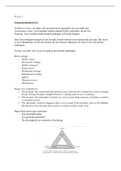Samenvatting
Samenvatting Daders inclusief voorgeschreven aritkelen
- Instelling
- Universiteit Leiden (UL)
Samenvatting Daders van Criminologie Universiteit Leiden. Bevat aantekeningen van de voorgeschreven artikelen, de hoorcolleges en de werkgroepen.
[Meer zien]




